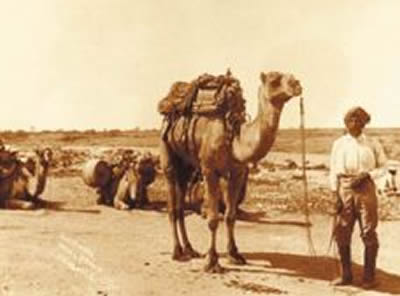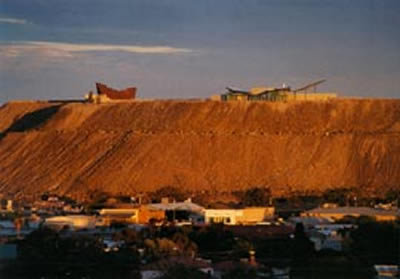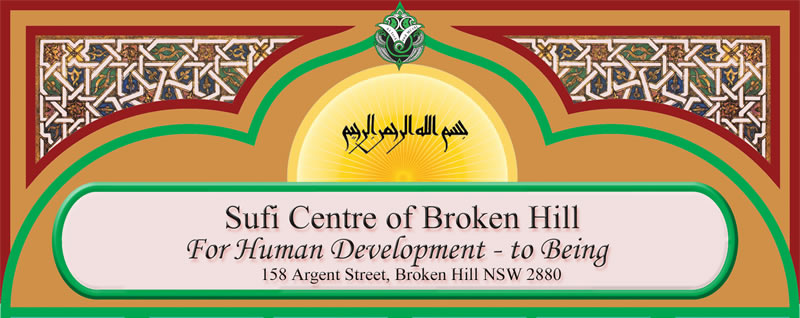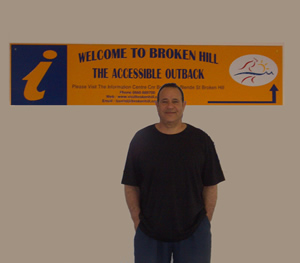Islamic History in Broken Hill

A brief history
of Broken Hill
from the Papers of the Centre
|
|
|
Murshid
F. A. Ali ElSenossi
|
"Then
there came running, from the farthest part of the City, a man, saying,
'O my people! Obey the Messengers:
Obey those who ask no reward of you (for themselves), and who have
themselves received Guidance.
It would not be reasonable of me if I did not serve Him Who created
me, and to Whom you shall (all) be brought back'."
(Holy Qur'an 36:20-22)
"Beyond the Darling River on the edge of the sundown, is where
they used to say you would find Broken Hill, as if there was nowhere
further to travel in Australia. Perhaps it was the feeling of suddenly
being confronted by such vast space, like an inland sea rolling into
the sunset.
The desolate landscape surrounding the town is like driving towards
a painting of soft mauve and sage hues. Is it any wonder the city
has become known as a 'mecca' for artists? It is here that the magnificent
clear blue skies and the magic light are also much loved by film makers.
It is here that the big red roos run two hundred kilometres in a night
chasing a thunderstorm, and the unique Sturt Desert Peas bloom in
dark red soils.
Did you know?
The City of Broken Hill is the largest regional centre in the western
half of New South Wales.
It lies in the centre of the sparsely settled New South Wales Outback,
close to the South Australian border and midway between the Queensland
and Victorian borders.
The nearest large population centre is Mildura in Victoria, three
hundred kilometres distant to the south on the Murray River.
The nearest large city is Adelaide, capital of South Australia, approximately
500 kilometres to the southwest.
Because of its location Broken Hill has strong cultural and historical
connections with South Australia and operates on Central Australian
Time, one half hour behind Eastern Standard Time ". (Broken Hill
City Council - Profile www.brokenhill.nsw.gov.au)
The term 'Broken Hill' was first used by the early British Explorer
Charles Sturt in his diaries during his search for an inland sea in
1844. Western plains towns far away from the major rivers, such as
Broken Hill, owe their existence to the mineral discoveries made in
the decade after 1875, when spectacular deposits of gold, silver,
copper and opal were found.
The township of Broken Hill was developed in the "Broken Hill
Paddock" which was part of Mt. Gipps Station. George McCulloch,
the station manager, employed many men; and it was in 1883 that three
of his workers pegged the first mineral lease on his property; they
were Charles Rasp, David James and James Poole. (Drewery, 1985 &
Camilleri, 2009). These men, along with four others formed the 'Syndicate
of Seven' later that year. They were the original members of the Broken
Hill Mining Company formed in 1883, who lodged applications for mining
leases along the Line of Lode.
The members, who all worked at Mount Gipps Station, were:-
1. George
McCulloch (1848-1907)-Station manager.
2. Charles Rasp (1846-1907)-Boundary rider.
3. Philip Charley (1863-1937)-Sheep farmer, employed as a boundary
rider.
4. David James (1854-1926)-Tank and fencing contractor.
5. James Poole (1848-1924)-Employee of David James.
6. George Urquhart (1845-1915)-Bookkeeper and overseer
7. George Lind (1861-1941)-Storekeeper.
Each member
paid £70 to be a member of the Syndicate and in September 1883
they pegged seven 40 acre blocks along the Lode. The initial results
were not encouraging and Poole, Urquhart and Lind sold their shares
before the boom days and flotation of Broken Hill Proprietary (now
known as BHP) in 1885. These men pegged out the remaining six mineral
leases which are known as the Line of Lode. It was the seventh member
of the Syndicate, Philip Charley, who found the first amount of silver
in 1885 .(Drewery, 1985 & Camilerri, 2009). A township was soon
surveyed and Broken Hill was initially a shanty town with an entire
suburb named 'Canvas Town' for its temporary buildings. Today, the
'Line of Lode' is a 30 metre high mullock heap that bisects Broken
Hill. The Visitor's Centre, Miners Memorial and Broken Earth Café
perch atop this unmistakable landmark.
Aboriginal
history of the area
There were some fifteen groups of Aboriginal people traditionally
living in the huge area bisected by the Darling River in the western
plains of NSW. The principal group around Broken Hill was the Wiljakali
Tribe. Their occupation of the area is thought to have been intermittent
due to the scarcity of water. The same scarcity of water made the
area unattractive for European occupiers, and traditional Aboriginal
ways of life continued longer there than in many other parts of NSW,
into the 1870s. However, mobility was essential to life in the mallee
and sand hills, and as Aboriginal people were increasingly deprived
of the full range of their traditional options, they were obliged
to come into stations or missions in times of drought to avoid starvation.
By the 1880s traditional lifestyles were largely supplanted by mission
lifestyles, with many Aboriginal people also working on stations or
within the mining industry. With the failure of most of the stations
during the 1890s depression, many local Aboriginal groups were again
displaced and ended up living in reservations created under the Aborigines'
Protection Act of 1909. The influenza epidemic of 1919 had a further
significant impact upon the indigenous population(HO, 1996, 192-193.)
as did the twentieth century federal government policy of removing
Aboriginal children from their families.
 |
 |
|
Afghan
Cameleer
|
The
Line of Lode and the Miner's Memorial
|
Cameleering
history in Australia and Broken Hill
Camel drivers led hundreds of camel trains throughout inland Australia
in the nineteenth century and by the turn of the twentieth century
their camel trains provided transport for almost every major inland
development project. The cameleers laboured across the continent,
carting produce, water, mail and equipment at a time when roads and
railways were not constructed. The indomitable camels and their equally
hardy keepers were crucial to momentous projects such as the construction
of the Overland Telegraph, for which they carried supplies and materials
used in surveying and construction work. They also accompanied a number
of exploration parties into the little-known interior. These early
Cameleers contributed greatly to the development of rural and remote
Australia (Powerhouse Museum, 2008 & National Archives of Australia,
2007).
It is estimated that some 20,000 camels were brought to Australia
during the second half of the nineteenth century from all different
parts of the world to work in the vast areas of inland Australia.
Their drivers came from different countries and provinces such as
Kashmir, Sind, Rajasthan, Egypt, Persia, Turkey, Punjab, Baluchistan,
and former provinces of Afghanistan, now modern day India and Pakistan.
Collectively they were known as "Afghans," although very
few were actually of Afghani descent, it is now widely (and subjectively)
used to describe the Cameleers (Australian Government: Culture Portal,
2009 & Camilleri 2009).
The Afghans were of the Islamic faith and practising Muslims; they
introduced their culture, customs and religion to NSW and also brought
a varied vocabulary of terms to Australia. The only word that found
a place in the Australian language was the command "hooshta",
which ordered the camel to kneel or rise. The Australian equivalent
is the word 'hoosh' or 'whoosh' which was universally used by cameleers
(Powerhouse Museum, 2008)
.
The forerunners of the camels to enter the Broken Hill district were
imported in 1866 by Sir Thomas Elder for use in Northern South Australia.
The Afghans, or Ghans as they became known, were well established
by the time of Broken Hill's discovery in 1883 and in succeeding years,
camel teams and Afghans were a familiar sight in Broken Hill and the
West Darling District of NSW. Camels were used to haul heavy wagons,
and twelve or more camels were used to pull a ten ton wagon travelling
at a rate at 15 miles per day (Powerhouse Museum, 2008).
Once camp was reached the Afghans slept in a temporary corrugated-iron
shed or bower of gum branches. They led a nomadic life with few personal
possessions. The Afghans generally lived away from white populations,
at first in makeshift camel camps, and later in Ghan towns on the
edges of existing settlements(Powerhouse Museum, 2008). For most of
the year they were solitary travellers lacking the camaraderie and
powerful sense of community or 'Ummah' that Islam bestows. The Afghans
performed their prayers five times daily out in the desert, the empty
bushland, or countryside. In Islam great emphasis is placed on the
conduct of prayer. Salat can be performed at any clean place ensuring
that the worshipper is directed towards the Ka'aba in Mecca. A mosque,
which is referred to in Arabic as a 'Masjid,' lit. 'Place of prostration',
is a dedicated place of worship. It is a place to gather for daily
prayers and festivals, and a place where the community come together
for spiritual advancement, through prayers and remembrance and through
religious education. A mosque can also be a reference point for other
community activities. Mosques should remain an Islamic endowment (waqf)
which is owned and looked after by the Muslim community.
Over the following four decades, the Afghans and their camels were
to play a crucial role in almost all subsequent exploratory expeditions
and scientific survey parties in the outback. Afghans were consequently
among the first non-Aboriginals to view such iconic landmarks of central
Australia, such as Kata Tjuta and Uluru, and had their own names ascribed
along the way to places such as Allanah's Hill and Kamran's Well as
the explorers mapped the emerging geography they traversed (Scriver,
2004)
.
Within just six years of the arrival of Elder's first camels, and
just a decade after Burke and Wills' first north-south crossing of
the continent, the Afghans with their camels had built the overland
telegraph from Adelaide through to Darwin that would connect Australia
direct to London. The construction of railways was shortly to follow
including the Afghan's namesake, the famous Ghan line from Port Augusta
to Alice Springs. The Ghan service's name is an abbreviated version
of its previous nickname 'The Afghan Express,' which comes from the
Afghans that trekked the same route as the overland telegraph, which
is said to have been the to be the route taken by John McDouall Stuart
during his 1862 crossing of Australia before the advent of the railway
(Burton, 2006).
The Afghans travelled lightly and were always ready to move. The men
were typically engaged on limited term contracts, and immigration
laws did not allow for women or children to accompany them to Australia.
Many therefore worked and lived communally as a brotherhood of fellow
cameleers, observing strict religious and related halal dietary practices
that tended to discourage significant social interaction with others.
Theirs was an itinerate mode of dwelling negotiated spatially through
movement, camping along the camel trails, resting between journeys
in their Ghan towns (Scriver, 2004).
Broken Hill was a central hub at which several important camel trails
and stock droving routes of the outback met the railroad and became
a prominent place of commercial interaction between Afghans and Europeans.
With its high concentration of Afghans, the camp at Broken Hill developed
as one of the most established Ghan towns of the outback (Camilleri,
2009).
The Ghan town along with the dwellings of the local Aboriginal people
were rarely located near the centre of town, which clearly segregated
the whites from the 'others'. Essentially in towns where the Afghans
worked there were three groups, a camp for the Afghans, a camp for
the local Aboriginal people and, in town was where the Europeans lived.
Despite the cameleers' historical and instrumental role in the development
of NSW, the lack of substantive material and proprietary claims to
'place' on the part of most of these men denied them recognition as
a constituent community within the emerging cultural fabric of the
new nation. Along with Aboriginal people, the Afghans experienced
racial discrimination and both spatial and economic marginalisation
in the Australia of the early twentieth-century (Scriver, 2004). Labour
unions representing the powerful lobby of white teamsters had long
orchestrated racist antagonism against the Afghans in an unsuccessful
bid to exclude them and their camels from the transport business.
But once the teamsters began to replace their horses with motorised
vehicles, the competitive advantage of camels was rapidly overcome.
By the time of the First World War, there was little place or purpose
remaining for the camels and the Afghans within NSW (Scriver, 2004).
Out-of-work cameleers were compelled to come in from the bush and
shift into other forms of employment wherever they could find it.
Many became hawkers and day labourers, eking out a living in the margins
of larger urban settlements such as Adelaide and Broken Hill.
Following the war, camel transport was finally eclipsed in Australia.
In due course the Afghan cameleers substantially vanished. Some returned
to Afghanistan or resettled in the new Islamic state of Pakistan that
emerged. Most Afghans who came to Australia were single or if married
left their wives behind as they expected to return wealthy. Many remained
single; others married Aboriginal women and a few married European
women. Those who took wives in Australia were ultimately assimilated,
according to the strict segregationist policies of the government,
into either the Aboriginal or European communities.
Even the Ghan towns-the only material places the Afghans had called
home-were gradually abandoned as they lost their economic base.
 |
|
Afghan
Mosque at Broken Hill, NSW
|
Broken
Hill Mosque
Australia's first mosque was built at Maree in northern South Australia
in 1861, the first large mosque was built in Adelaide in 1890, and
the first mosque in NSW in Broken Hill in 1887. The mosque was originally
located at a camp in West Broken Hill and was relocated to its present
site about 1903-1904. It was constructed by the Afghans and comprises
a modest structure made from wood and corrugated iron sheeting, painted
rust red (which is the colour of the original mosque and a typical
colour of Broken Hill). The adjoining anteroom is also constructed
of the same materials. The mosque sits on a dusty site at the edge
of town, with an avenue of date palm trees, planted in 1965 by the
Broken Hill Historical Society. At the entrance of the site are two
olive trees which were planted by The Islamic Council of NSW in December
2008. Surrounding the mosque are original camel wagon wheels made
from wood and iron used by prominent Afghans in the town; mainly Shamroze
Khan and Poujen Khan. To the far eastern corner of the site is the
water trough used by the men to make their ablutions before they entered
the mosque. Upon removing their footwear the men stood beside the
concrete channel as water was poured over their feet and they entered
the mosque using specially constructed stepping stones which are now
housed in the adjoining museum.
The Afghan mosque and camp was described in 1955 by Colin Sayers of
Broken Hill in the 'Melbourne Age' as:
"Two
camps of teamsters on the sandy outskirts of the town, squalid collections
of rusty corrugated iron and hessian humpies. They were at most two
roomed dwellings . . . narrow, rutted lines bisected the huts. There
was a stone built mosque in a small, sandy square, its low minaret
scantily shaded by a dusty pepper tree. They were picturesquely squalid
characters, known popularly among us in boyhood years as "hooshtas"
from the command they gave the camels... All of them wore turbans
and long baggy white cotton trousers. Sunday mornings we visited the
"Ghan" camps...Children in large number played in the dust
at the doors of the huts..." (Solomon, 1988).
The men, particularly the older and more devout Muslims, went to the
mosque regularly; especially on Friday which is the traditional Muslim
day of gathering. Some Afghans would not work on a Friday between
noon and 2 pm. A mosque attendant would call the men to prayer by
singing out loudly from the mosque's grounds. One Broken Hill Afghan
descendant, Abdul Fazulla, could recall seeing such a person, Mohamed
Raffeeg, standing on the cement outside the mosque, putting his hands
cupped with palms outward to the side of his face and making the call
to prayer. His voice travelled over the camp to the Ghan town at the
north end of Chapple Street (Rajkowski, 1987). If the devotees were
not near a mosque for the morning or evening prayers, they would pray
wherever they were. Many old-timers from Broken Hill recall seeing
Afghans in the bush working with their camel trains, stopping mid
way at a certain time, kneeling on their mats praying (Rajkowski,
1987).
The mosque was well used even when the Ghan community diminished in
later years and the few Muslims remaining in Broken Hill continued
to use it regularly up till 1940 and then less frequently until the
death of the last Mullah in the 1950's. After his death the mosque
fell into disuse and was vandalised.
Dost Mahomet was a prominent Afghan Camel driver who worked at Broken
Hill. He arrived with the camels and later travelled part of the distance
and assisted the explorers. His grave lies three kilometres from Menindee,
on the road to Broken Hill, and is the first known Muslim person to
be buried on Australian soil (Matthews, 1997).
At present there are few descendants of the early Afghan families
in Broken Hill. The mosque has been renovated and refurnished by members
and friends of the Broken Hill Historical Society and the Islamic
Council of NSW to mark a unique but important phase in the development
of transport in the West Darling district of NSW.
Current history
The Broken Hill Mosque is located on the corner of 703 William Street
and 246 Buck Street, Broken Hill. However this is not the initial
site of the mosque. The Cameleers lived in two camps, one at North
Broken Hill, off the end of Chapple Street, and the other camp at
West Broken Hill on the corner of Kaolin and Brown Streets. There
was a small mosque at the west camp which was relocated when the area
was developed for houses and placed behind the mosque at the main
north camp.
The land upon which the Broken Hill Mosque currently sits was first
granted in 1891 as part of 'Portion 1940', bought by David (or Daniel)
Miller of Broken Hill (Hanna, 2009). In 1903 Miller sold the portion
to 'Afzul of Broken Hill, camel driver'. It fell to disrepair after
the death of Afzul, the last regularly practising Muslim and acting
Mullah. The land and mosque was then acquired by his son, Abdul Fazulla
of Broken Hill, a truck carrier/labourer in 1961 (Hanna, 2009).
After Council had acquired the title to the block for non payment
of rates, it was renovated and refurnished by members and friends
of the Broken Hill Historical Society who are now its trustees. In
September 1968 it was officially opened. The ceremony was attended
by the Towns Mayor and visitors from a mosque in Adelaide were invited
to worship and bless the site to show it be a sacred and Holy place
in NSW's Islamic community and culture. The mosque is one of the last
remaining remnants of "Afghan" immigration to NSW and embodies,
in built form, early Islamic culture in Australia which is otherwise
not so significantly represented in the State.
A small museum has been established in the anteroom of the mosque
for display of camel bells, nose pegs, photographs, the original stepping
stones, camel saddles, traditional female and male headgear from Baluchistan,
and in a glass showcase is a walking stick that belonged to the last
Mullah along with other items associated with the Islamic religion.
The museum is open to the public every Sunday from 2pm-4pm and can
be opened for worship on request.
References:
Broken Hill City Council: www.brokenhill.nsw.gov.au
Broken Hill Historical Society
H.M. Barker 1957 Camels and Afghans
Muslims in Australia from: (www.imamreza.net/eng/imamreza.php?id=3926)
A brief history of the Muslim Community in Australia (www.islamfortoday.com/australia.htm)
Jamila Hussain Islam its Law and Society - Chapter 15
National Archives of Australia, Muslim Journeys (www.uncommonlives.naa.gov.au/)
Peter Scriver,2004 Mosques, Ghantowns and Cameleers in the Settlement
History of Colonial Australia.
Rosamund Burton Dr. Anne Monsour and Paul Convy, 2006, Into the Red
New South Wales, www.news.com.au.
South Australian Museum, 2008, Australia's Muslim Cameleers- Pioneers
of the Inland 1860-1930, (http://www.samuseum.sa.gov.au/page/default.asp?site=1&id=1561)
Zachariah Matthews, 1997, Origins of Islam in Australia (www.worldupdates.tripod.com/newupdates10/id17.htm)
Bill Seager, 2007, Australia's Muslim Cameleers: Pioneers of the Inland
Christine Adams , 2004, Sharing the Lode: the Broken Hill Migrant
Story
Christine Stevens, 1989, Tin Mosques and Ghantowns; A history of Afghan
Camel Drivers in Australia
H.M. Barker, 1972, Camels in the Outback
Jenny Camilleri -Presdident of the Broken Hill Historical Society
Inc, 2009, Personal communications with Patrica Assad at the Heritage
Branch.
Kevin Baker, 2006, Mutiny, Terrorism, riots and murder: A history
of sedition in Australia and New Zealand.
Powerhouse Museum, 2008, Powerhouse Museum Collection Search: Camel
Saddles
R.J. Solomon, 1988, The Richest lode: Broken Hill 1883-1988 .
Roberta J Drewery, 1985, Streets of History: naming our streets, Broken
Hill, NSW
Roberta J Drewery, 2008, Treks, Camps, and Camels: Afghan Cameleers
and their contribution to Australia.
Tom L. McKnight, 1969, The Camel in Australia Unpublished Report for
the Heritage Branch by Bronwyn Hanna 2009, Broken Hill Historical
Title Search





